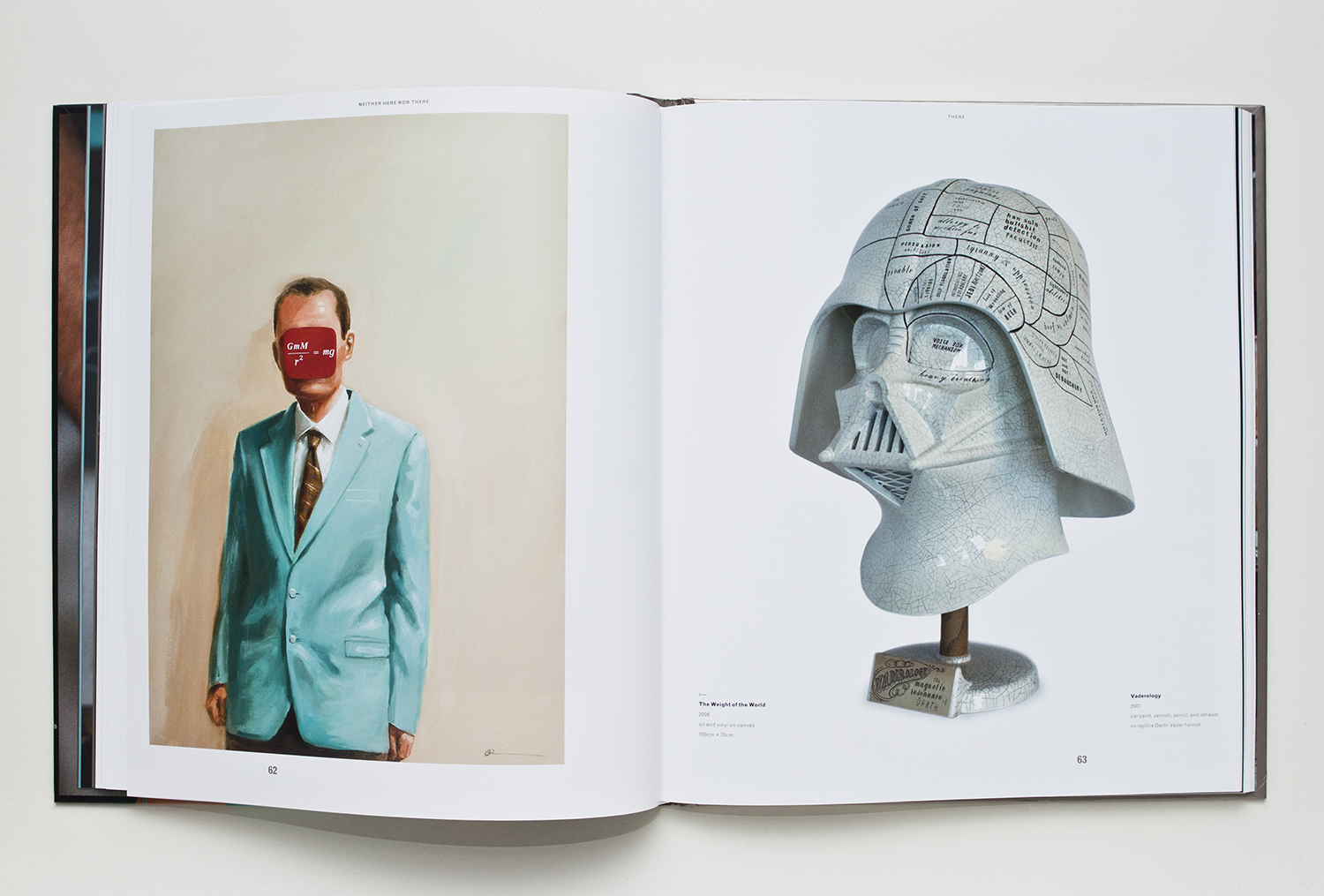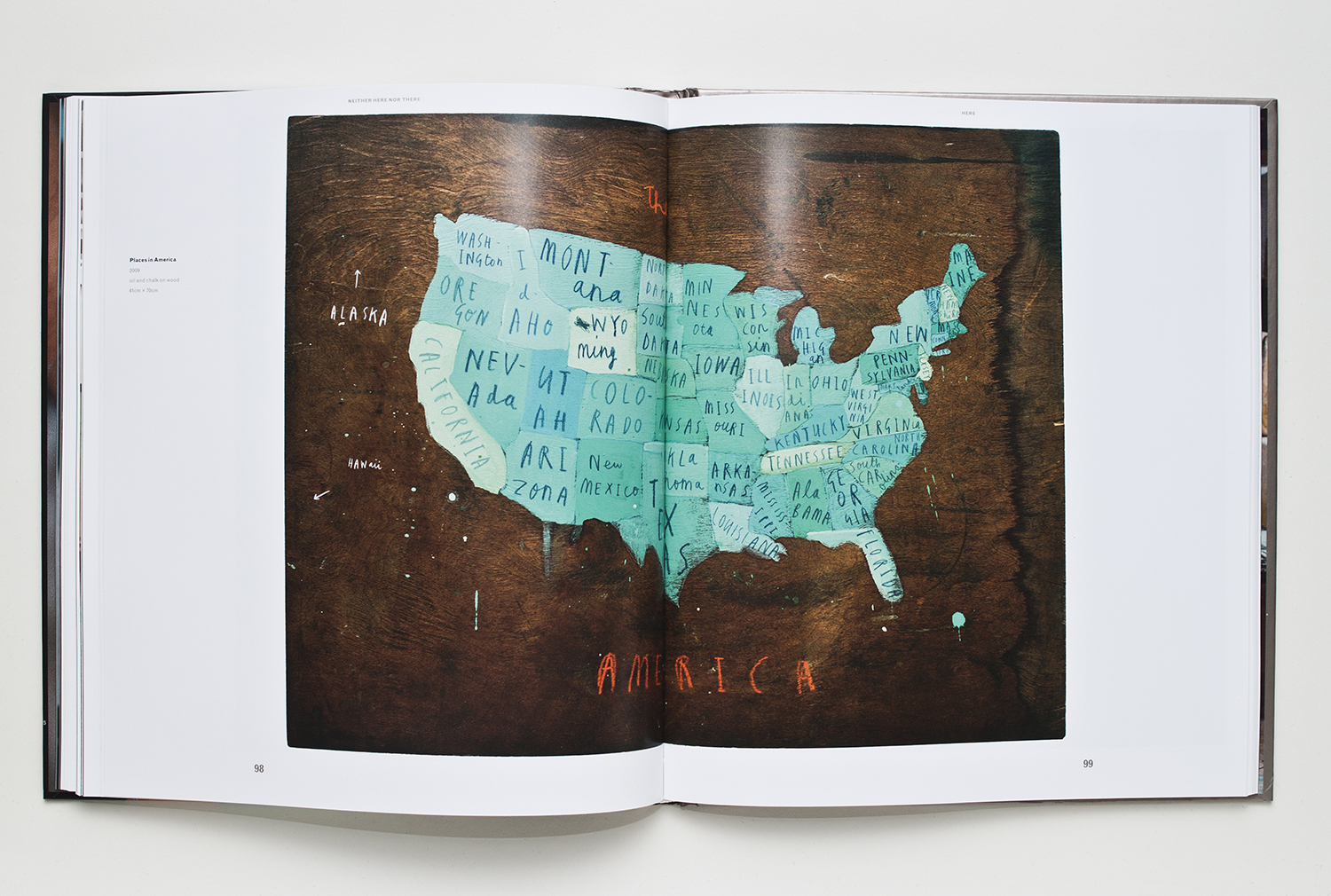OLIVER JEFFERS "NEITHER HERE NOR THERE"

Recently we came across the work of artist Oliver Jeffers (f. 1977), when Gestalten published a monograph about him titled “Neither Here Nor There.” We were instantly drawn by his flawless painting technique, discrete choice of color and down toned sense of humour. Oliver is an artist with clear interests and his use of scientific and mathematic references breed curiosity and continues to amaze us.
We were lucky to get the book and had a closer look on the marvelous work of Oliver Jeffers. The book includes a preface by editor Richard Seabrooke and an introduction by Oliver’s friend and fellow artist, Mac Premo which, together with small stories and work descriptions throughout the book, gives a nice insight into Oliver’s thoughts and ideas. However our curiosity grew and we had to send some questions in Oliver’s direction. Now we are happy to share this wonderful talent with you all together with a good bunch of reflections and memories from the artist himself.
Oliver Jeffers "Neither here nor there" | Photos by I DO ART Agency.
Can you tell us about yourself, and take us on a tour through your life?
I’m Northern Irish. I grew up in Belfast, but had a relatively normal upbringing despite the political turbulence and violence that was going on around me. My parents attempted to leave in the early 70s, and lived in Australia for a while. I was born while they were there, but it didn’t work out for a variety of reasons and so they were back in Belfast before I was a year old.
I have a big family, many of whom are very creative, so my creativity was always encouraged. I have 3 brothers and learned how to navigate around other people early on. We were quite catholic when I was growing up, and when my parents decided to send me to an integrated secondary school, one of the first of its kind in Northern Ireland, where catholics and protestants were educated together, two distinct things happened. Firstly, the parish priest found out and condoned their decision, letting to a heated argument with my dad, who believed integration was the only way to begin an honest dialogue between the warring communities. This was the beginning of me seeing religion for what it was, an elaborate form of control. A few years later when I started reading about science for pleasure, my relationship with organized religion came to a formal end. The second thing that happened by going to an integrated school came about because the school, in its infancy and needing numbers to meet funding requirements, started accepting rough kids who’d been kicked out of other schools. Being academic was definitely frowned upon by the general body of students, but because I was drawing on peoples skateboards and schoolbags, my interest in art was accepted.
Because I was a student who showed an interest in anything at all, my foray into art was wildly encouraged by the teachers, something that would not have happened had I been sent to a ‘proper’ school, and instead I’d have been encouraged to become a soliciter or engineer.
My interest in travel began early, with an opportunity opening up for my dad to send my brother and I to a summer camp in upstate New York on a scholarship. Through friends that I met and kept in touch with, years later I visited New York City, my future adopted home.
Another place I visited, when I took some time off from art college was Australia, taking advantage of my second passport. I lived in Sydney for a while working in a bar and trying to sell paintings. It was there I had the idea for my first picture book, although I didn’t realize it at the time – the idea was originally intended to be a single painting as part of a show I was building up to. When I went back to art college I made the mental jump to picture books, and after graduating got my book published. I was still living at home at the time and was able to use the modest advance and royalties from early sales to pay for my continuing art practice. Over the next few years this was the case for both picture books and commercial illustration, the latter, however was starting to eat more and more into my time, and it was with increasing self discipline that I continued artistic endeavors and projects. It was one of these projects that brought me back to New York to exhibit. While there it felt like I shouldn’t leave. It took me about 3 more years to get my visa and I’ve been living there for over 5 years now.
Has art always been the natural way of expression for you?
I suppose it has. When I think back I remember occasions where I was definitely expressing myself through image making, even when I was quite small, though I wasn’t aware of it at the time, or even had that term in my vocabulary. Much of it came down to a love of drawing.
Making something in a two dimensional form that was either based on the three dimensional world, or more often than not, straight from my imagination, so without any dimensions at all – giving form to thought. It all seemed so liberating and empowering.
I responded well to being complimented, and that became a part of it too, though it wasn’t until the early stages of art college that I realized that this was actually a destructive force – doing something because you wanted someone else to like it, or you, or be accepted, and it was ultimately an obstacle to total self expression. I learned to let go of this, and it was then that I found the art that I truly wanted to make. I realize now that I was trying on lots of different hats to see what would fit, both in terms of style/technique but also subject matter. Things really started to take shape when I learned to listen to myself more – listen to the way my hands wanted to make, and listen to the concepts my mind wanted to explore.
Can you take us through your artistic process?
How do ideas appear and when is a work ‘done’?
The process changes for different projects, pieces and mediums, but ultimately, the concept is king, and the technique or medium is used to execute the concept in the most effective way. Ideas come from anywhere at anytime. My mind makes connections that I don’t fully understand, and my art in large parts is about trying to understand. The pieces are all connected, all lines of enquiry that begin from the same place. Sometimes ideas come for a new piece when I’m in the middle of a current piece, sometimes from something I’m reading, a conversation I overhear. From anywhere. The secret is recording the moment I think of something. However straightforward and obvious something might seem at the time, if I don’t write it down, chances are I wont remember the composition in a day or two.
As far as when something is done, this too depends on circumstances. Often I impose self inflicted deadlines and work backwards from a date. Sometimes the work is done when I run out of time. This is more relevant to project based work. Otherwise, knowing when to stop can be an art form. I sometimes liken the act of painting to a wrestling match. Its never a formula where you can predict how easily the paint will fall into place. I’ve always liked the Michael Borreman quote where he describes getting something right, even a little detail, as a ‘knife in the eye’. I know exactly what he means by this and its what I seek to find in my work. Though sometimes this happens accidentally right off the bat, and sometimes it takes months.
What inspires you the most at the moment?
My work has been going down the line of exploring the gaps between different ways of thinking. I’ve been fascinated for a long time by our scientific understanding of how our world works and how this differs from our personal stories. Specifically I’m inspired by things that we don’t yet know, or that exist that we cant see. As a result I’ve been making pieces where I create something pictoral or figurative and then destroying or hiding it. I’m also aware that I’ve been going down a bit of a rabbit warren in terms of my artistic line of enquiry, and as a by product of that I’ve been inspired by levity, in finding humor in everything and being as honest as possible. I’m also constantly inspired by people, random human connections, and good solid chats with good solid friends.
What are your hopes and dreams for the future?
Really, to just keep doing what I’m doing. To make work on a bigger scale and get a bigger studio. I’ve been getting more selective about the work I take on in a publishing and commercial capacity in order to leave time for my art practice. I’m getting closer to a good balance, and as a result phasing out commercial work altogether. I also want to calm down a bit and enjoy the wonderful life I have and wonderful people I’m surrounded by. But I also want to keep challenging and pushing myself.
My problem is that I get bored easily, so once I reach a target, I quickly become restless. And maybe this isn’t a bad thing.
Anything else you would like to add?
Only that I hope you enjoy looking at the monograph, Neither Here Nor There which is a collection of the last ten years of my art practice. I think for the first time people have been making the connections about my work that I’ve been making inside my head for years. Now that they can see it all together, the arc is making sense. It was also an excellent opportunity to take stock of where I’ve been and where I’m going. The most exciting realization was that I’m only just warming up!
Rikke Luna (f. 1988) og Matias B. Albæk (f. 1988) er stiftere af idoart.dk, og driver derudover formidlingsbureauet I DO ART Agency samt I DO ART Books.
























